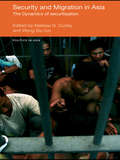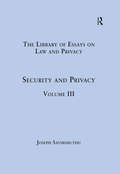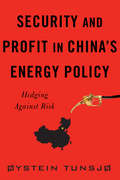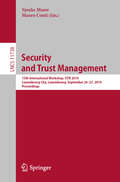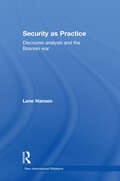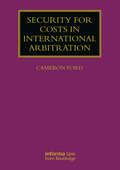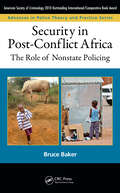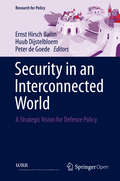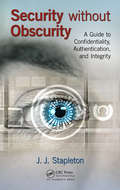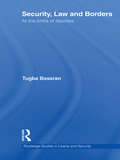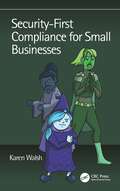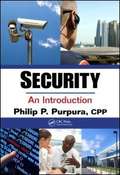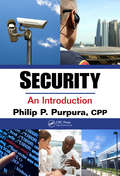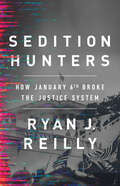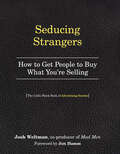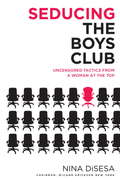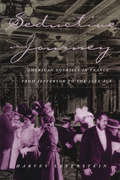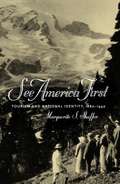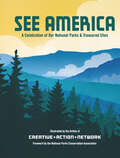- Table View
- List View
Security and Defence in Europe (Advanced Sciences and Technologies for Security Applications)
by J. Martín Ramírez Jerzy BiziewskiThis book argues that security and defense have never been true priorities in the European Union, and have constantly been marginalized by the elites since the Soviet Union collapsed and the Warsaw Pact disintegrated. Despite the official rhetoric, only a few tangible results can be presented concerning the operational readiness of European forces, and the EU’s inability to act was proven during the crises in the Balkans, NATO has experienced similar problems, as the majority of its members are EU countries. Both organizations have declared their resolve concerning the security and defense of their nations and territories, but, unfortunately, little has been done to lend these statements credence. In this context, the book analyzes several aspects of EU security and defense, including: the EU – NATO relationship, common defense policy and strategy, common capability building, common understanding of strategic changes, common operational planning and centrally synchronized exercises based on operational planning, etc. The member states have helped to make EU/NATO effective organizations, but unfortunately their individual interests and priorities constitute real challenges. This aspect should be discussed and addressed by political and military elites, scholars, analysts, students and the general public alike.
Security and Migration in Asia: The Dynamics of Securitisation (Politics in Asia)
by Wong Siu-Lun Melissa CurleySecurity and Migration in Asia explores how various forms of unregulated and illegal forms of human movement within Asia and beyond the region have come to be treated as 'security' issues, and whether and how a 'securitization' framework enables a more effective response to them. The process and theory of 'securitization' and 'desecuritization' have been developed within the international relations literature by the so-call Copenhagen school scholars, including Barry Buzan and Ole Waever among others. The topics explored in this well- presented and engaging book cover geographic areas of China, Northeast Asia, Central Asia, the Russian Far East, Southeast Asia, and the Hong Kong SAR, and includes research on: human trafficking and people smuggling financing illegal migration and links to transnational organized crime regulated and unregulated labour migration the 'securitization' of illegal migration in sending, transit and receiving countries. This book provides compelling insights into contemporary forms of illegal migration, under conditions of globalization, and makes a contribution to the literature in international relations and migration studies.
Security and Privacy: Volume III (The Library of Essays on Law and Privacy #3)
by Joseph SavirimuthuDuring the last decade in particular the levels of critical engagement with the challenges posed for privacy by the new technologies have been on the rise. Many scholars have continued to explore the big themes in a manner which typifies the complex interplay between privacy, identity, security and surveillance. This level of engagement is both welcome and timely, particularly in a climate of growing public mistrust of State surveillance activities and business predisposition to monetize information relating to the online activities of users. This volume is informed by the range of discussions currently conducted at scholarly and policy levels. The essays illustrate the value of viewing privacy concerns not only in terms of the means by which information is communicated but also in terms of the political processes that are inevitably engaged and the institutional, regulatory and cultural contexts within which meanings regarding identity and security are constituted.
Security and Profit in China’s Energy Policy: Hedging Against Risk (Contemporary Asia in the World)
by Øystein TunsjøChina has developed sophisticated hedging strategies to insure against risks in the international petroleum market. It has managed a growing net oil import gap and supply disruptions by maintaining a favorable energy mix, pursuing overseas equity oil production, building a state-owned tanker fleet and strategic petroleum reserve, establishing cross-border pipelines, and diversifying its energy resources and routes.Though it cannot be "secured," China's energy security can be "insured" by marrying government concern with commercial initiatives. This book comprehensively analyzes China's domestic, global, maritime, and continental petroleum strategies and policies, establishing a new theoretical framework that captures the interrelationship between security and profit. Arguing that hedging is central to China's energy-security policy, this volume links government concerns about security of supply to energy companies' search for profits, and by drawing important distinctions between threats and risks, peacetime and wartime contingencies, and pipeline and seaborne energy-supply routes, the study shifts scholarly focus away from securing and toward insuring an adequate oil supply and from controlling toward managing any disruptions to the sea lines of communication. The book is the most detailed and accurate look to date at how China has hedged its energy bets and how its behavior fits a hedging pattern.
Security and Trust Management: 15th International Workshop, STM 2019, Luxembourg City, Luxembourg, September 26–27, 2019, Proceedings (Lecture Notes in Computer Science #11738)
by Sjouke Mauw Mauro ContiThis book constitutes the proceedings of the 15th International Workshop on Security and Trust Management, STM 2019, held in Luxembourg City, Luxembourg, in September 2019, and co-located with the 24th European Symposium Research in Computer Security, ESORICS 2019. The 9 full papers and 1 short paper were carefully reviewed and selected from 23 submissions. The papers present novel research on all theoretical and practical aspects of security and trust in ICTs.
Security as Practice: Discourse Analysis and the Bosnian War (New International Relations)
by Lene HansenThis important text offers a full and detailed account of how to use discourse analysis to study foreign policy. It provides a poststructuralist theory of the relationship between identity and foreign policy and an in-depth discussion of the methodology of discourse analysis. Part I offers a detailed discussion of the concept of identity, the intertextual relationship between official foreign policy discourse and oppositional and media discourses and of the importance of genres for authors' ability to establish themselves as having authority and knowledge. Lene Hansen devotes particular attention to methodology and provides explicit directions for how to build discourse analytical research designs Part II applies discourse analytical theory and methodology in a detailed analysis of the Western debate on the Bosnian war. This analysis includes a historical genealogy of the Western construction of the Balkans as well as readings of the official British and American policies, the debate in the House of Commons and the US Senate, Western media representations, academic debates and travel writing and autobiography. Providing an introduction to discourse analysis and critical perspectives on international relations, this book will be essential reading for students and scholars of international relations, discourse analysis and research methodology.
Security beyond the State
by Rita Abrahamsen Michael C. WilliamsAcross the globe, from mega-cities to isolated resource enclaves, the provision and governance of security takes place within assemblages that are de-territorialized in terms of actors, technologies, norms and discourses. They are embedded in a complex transnational architecture, defying conventional distinctions between public and private, global and local. Drawing on theories of globalization and late modernity, along with insights from criminology, political science and sociology, Security Beyond the State maps the emergence of the global private security sector and develops a novel analytical framework for understanding these global security assemblages. Through in-depth examinations of four African countries - Kenya, Nigeria, Sierra Leone and South Africa - it demonstrates how global security assemblages affect the distribution of social power, the dynamics of state stability, and the operations of the international political economy, with significant implications for who gets secured and how in a global era.
Security for Costs in International Arbitration (Lloyd's Arbitration Law Library)
by Cameron FordThis is the first and leading comprehensive guide to security for costs in international arbitration, including commercial and investment arbitration, providing a text which will be the key resource for those considering, making and ruling on applications for security for costs. It is the first and only work to consider the 40+ factors informing the discretion to award security for costs.The author begins with an introduction and description of the security of costs controversy in international arbitration, and then explains the developing approach of arbitral tribunals to applications for security for costs, with reference to decisions published by ICC and ASA, and statistics of LCIA and decisions of the UK courts when they had the power to grant security for costs in international arbitration. The book features an analysis of the reasons given for restricting security for costs in international commercial arbitration to ‘exceptional circumstances’ or similar. The author conveys discretionary factors taken into account by the courts and arbitral tribunals in considering applications for security for costs, special considerations for investor-state arbitrations, the correct approach to the exercise of the discretion, the manner of making and resisting applications, appropriate orders to be made on applications, and consequences of orders.This book is written for all arbitration practitioners around the world, including arbitrators ruling on applications. The work would be incidentally useful to litigation practitioners as it necessarily considers applications for security for costs in litigation.
Security in Post-Conflict Africa: The Role of Nonstate Policing (Advances in Police Theory and Practice)
by Bruce BakerPolicing is undergoing rapid change in Africa as a result of democratization, the commercialization of security, conflicts that disrupt policing services, and peace negotiations among former adversaries. These factors combined with the inability of Africa‘s state police to provide adequate protection have resulted in the continuing popularity of va
Security in an Interconnected World: A Strategic Vision for Defence Policy (Research for Policy)
by Huub Dijstelbloem Ernst Hirsch Ballin Peter De GoedeThis open access book follows the idea that security policy must be based on strategic analysis. Defence policy and the role of the armed forces can subsequently be determined on the grounds of said analysis. More than ever, internal and external security, and developments both in the Netherlands and abroad are interconnected. The world order is shifting, the cooperation within NATO and the EU is under pressure and the Dutch armed forces are gasping for breath. What is the task of Dutch security and the defence policy? There have been growing calls in the last few years to end the devastating cuts in the defence budget and to invest more in security. The acute threats and conflicts in which the Netherlands are involved have served as a wake-up call. The shooting down of Flight MH17 over Ukraine, the streams of refugees from Syria and other countries, the conflict with Da’esh in Syria and Iraq, and terrorist threats reveal how events in many of the world’s flash-points have a direct or indirect impact on the Netherlands. Conflicts in other countries have a spill-over effect in The Netherlands. This is illustrated by tensions between population groups and the clashes over the Gülen schools after the failed putsch in Turkey on 15 July 2016 and over the constitutional referendum in that country. How do we ensure that any additional funds are not divided amongst the branches of the armed forces without any sense of strategic direction? What should a future-proof security policy that plots the course of defence policy entail? What strategic analyses should lie behind the political choices that are made? This book answers these questions and offers a comprehensive framework addressing among other things human security, national security and flow security.
Security without Obscurity: A Guide to Confidentiality, Authentication, and Integrity
by J.J. StapletonThe traditional view of information security includes the three cornerstones: confidentiality, integrity, and availability; however the author asserts authentication is the third keystone. As the field continues to grow in complexity, novices and professionals need a reliable reference that clearly outlines the essentials. Security without Obscurit
Security, Law and Borders: At the Limits of Liberties (Routledge Studies in Liberty and Security)
by Tugba BasaranThis book focuses on security practices, civil liberties and the politics of borders in liberal democracies. In the aftermath of 9/11, security practices and the denial of human rights and civil liberties are often portrayed as an exception to liberal rule, and seen as institutionally, legally and spatially distinct from the liberal state. Drawing upon detailed empirical studies from migration controls, such as the French waiting zone, Australian off-shore processing and US maritime interceptions, this study demonstrates that the limitation of liberties is not an anomaly of liberal rule, but embedded within the legal order of liberal democracies. The most ordinary, yet powerful way, of limiting liberties is the creation of legal identities, legal borders and legal spaces. It is the possibility of limiting liberties through liberal and democratic procedures that poses the key challenge to the protection of liberties. The book develops three inter-related arguments. First, it questions the discourse of exception that portrays liberal and illiberal rule as distinct ways of governing and scrutinizes liberal techniques for limiting liberties. Second, it highlights the space of government and argues for a change in perspective from territorial to legal borders, especially legal borders of policing and legal borders of rights. Third, it emphasizes the role of ordinary law for illiberal practices and argues that the legal order itself privileges policing powers and prevents access to liberties. This book will be of interest to students of critical security studies, social and political theory, political geography and legal studies, and IR in general.
Security-First Compliance for Small Businesses
by Karen WalshOrganizations of all sizes struggle to secure their data in a constantly evolving digital landscape. Expanding digital footprints and the rapid expansion of cloud strategies arising from the COVID-19 pandemic increase an organization’s attack surface. When combined with limited resources caused by the cybersecurity skills gap, securing small and mid-sized business IT infrastructures becomes more complicated. With limited staffing and budgetary restrictions, small businesses need to create cost-effective, security-driven programs that protect data while also meeting increasingly stringent compliance requirements. This book bridges the gap between complex technical language and business objectives to create a security-first review of the security and compliance landscapes. Starting from the premise that “with security comes compliance,” this book starts by defining “security-first” and then walking readers through the process of creating a holistic security and compliance program. Looking at security and privacy through the lens of zero trust, this overview of regulations and industry standards provides both background about and implications drawn from modern security practices. Rather than focusing solely on individual cybersecurity frameworks, this book offers insights into best practices based on the commonalities between regulations and industry standards, highlighting some of the primary differences to show the nuances. Woven throughout are practical examples of solutions that enable small and mid-sized businesses to create “cybersustainable” security-focused policies, processes, and controls that protect today’s future for tomorrow’s digital ecosystem.
Security: An Introduction
by Philip P. PurpuraToday, threats to the security of an organization can come from a variety of sources ― from outside espionage to disgruntled employees and internet risks to utility failure. Reflecting the diverse and specialized nature of the security industry, Security: An Introduction provides an up-to-date treatment of a topic that has become increasingly complex as more vulnerabilities arise. <p><p> Philip P. Purpura, recently selected by Security Magazine as one of the Top 25 Most Influential People in the Security Industry, shares his 30-plus years of professional experience in the industry to provide basic theory and real-world methodologies that security practitioners can apply to scenarios they encounter. <p> Utilizing real-world examples, each chapter begins with learning objectives and a list of key terms and ends with discussion questions, role-playing exercises, and links to relevant websites. The book offers readers a foundation for understanding and implementing best practices for security to more effectively protect people, assets, and organizations.
Security: An Introduction
by Philip P. PurpuraToday, threats to the security of an organization can come from a variety of sources- from outside espionage to disgruntled employees and internet risks to utility failure. Reflecting the diverse and specialized nature of the security industry, Security: An Introduction provides an up-to-date treatment of a topic that has become increasingly comple
Sedalia Engine Plant (A)
by Michael Beer Bert A. SpectorThe new plant manager must deal with the problems and potentials contained in this highly participatory management style plant.
Sedimentation and Reservoirs of Marine Shale in South China
by Feng Yang Shang XuThis book systematically investigates the depositional process and reservoir characteristics of organic-rich shales, including (1) The types and development mechanisms of organic-rich shales under ancient ocean and climatic backgrounds. Schematic models are proposed to understand the organic matter enrichment and depletion in shale systems. (2) Microstructure and petrophysical properties. The general lithofacies are recognized and linked to the depositional setting and petrophysical properties. Full-scale pores and fractures are characterized using FE-SEM, gas adsorption, nano-CT and micro-CT scanning. (3) Brittle-ductile characteristics. Rock mechanical properties and in-situ stress are determined. The brittle-ductile transformation of shales is discussed. (4) Shale gas occurrence state and differential enrichment. Gas content and dynamic dissipation over geological time are evaluated using sorption experiments and numerical simulation. Shale gas enrichment model is developed to understand the gas differential accumulation in organic-rich shales. This book can be used for reference by researchers engaged in shale oil and gas geology in both academics and industry.
Sedition Hunters: How January 6th Broke the Justice System
by Ryan J. ReillyThe January 6th attack is an unprecedented crime in American history. Sprawling and openly political, it can't be handled by the traditional rules and norms of law enforcement--threatening the very idea of justice and its role in society. The attack on the Capitol building following the 2020 election was an extraordinarily large and brazen crime. Conspiracies were formed on social media in full public view, the law-breakers paraded on national television with undisguised faces, and with outgoing President Donald Trump openly cheering them on. The basic concept of law enforcement--investigators find criminals and serve justice--quickly breaks down in the face of such an event. The system has been strained by the sheer volume of criminals and the widespread perception that what they did wasn't wrong. A mass of online tipsters--"sedition hunters"--have mobilized, simultaneously providing the FBI with valuable intelligence and creating an ethical dilemma. Who gets to serve justice? How can law enforcement still function as a pillar of civil society? As the foundations of our government are questioned, the FBI and Department of Justice are the first responders to a crisis of democracy and law that threatens to spread, and fast. In this work of extraordinary reportage, Ryan Reilly gets to know would-be revolutionaries, obsessive online sleuths, and FBI agents, and shines a light on a justice system that's straining to maintain order in our polarized country. From the moment the police barriers were breached on January 6th, 2021, Americans knew something had profoundly changed. Sedition Hunters is the fascinating, high-stakes story of what happens next.
Sedona Verde Valley Art: A History from Red Rocks to Plein-Air
by Lili DeBarbieriThe jaw-dropping allure of the Sedona Verde Valley is a magnet for celebrated visual artists from around the world. This unforgettable landscape has inspired nearly a century of diverse painting, experimental collage, provocative sculpture and stimulating architecture. Tourists and locals are enamored of the Chapel of the Holy Cross, and the unique and often political art of Jerome continues to evolve. In a captivating exploration of state and regional styles alongside profiles of contemporary masters, author and historian Lili DeBarbieri presents the full story of Sedona art.
Seduce Me: A Stark Ever After Novella (Stark Series #18)
by J. KennerNew York Times bestselling author J. Kenner continues her beloved Stark series with a scorching-hot Stark Ever After novella for Nikki and Damien Stark as they make an impromptu getaway to Las Vegas. For fans of Fifty Shades of Grey, Sylvia Day, Meredith Wild and Jodi Ellen Malpas. There's no better place to turn up the heat than in Sin City...I've never felt as close to anyone as I have with Damien Stark. I know every line of his body, every secret within his soul. There's nothing I crave more than his touch, and with his kiss, he seals his claim.Las Vegas is the perfect place for us, where we can indulge every desire and fantasy. But when someone from my past resurfaces, I can't ignore my instinct that I have to make things right.With Damien by my side, I feel safe no matter the danger. Our passion protects us, drives us, makes us whole. His pleasure is an exquisite game, and one that I'll play forever.Find out how it all began for Damien and Nikki in J. Kenner's hot and addictive bestselling Stark series: Release Me, Claim Me, Complete Me, Take Me, Have Me and Play My Game.Return to the smoking hot Stark world with the Stark International trilogy: Say My Name, On My Knees and Under My Skin is the explosively emotional story of Jackson Steele and Sylvia Brooks.Don't miss J. Kenner's sizzling Most Wanted series of three enigmatic and powerful men, and the striking women who can bring them to their knees: Wanted, Heated and Ignited.***SEDUCE ME was previously published for a limited time in the SWEET SEDUCTION anthology***
Seducing Strangers: How to Get People to Buy What You're Selling (The Little Black Book of Advertising Secrets)
by Josh Weltman Jon HammThe author says it best: “This book is for people like you and me. People who go to work and—using words, pictures, music, and stories—are expected to make s**t happen . . . to make the phone lines light up and the in-box fill up. Attract fans, friends, and followers. Make the cash register ring. Win the business. Close the deal. Sell something.” Joshua Weltman knows just how to do that, and teach others how to do it, too. An advertising creative director for more than 25 years and the Mad Men co-producer responsible for Don Draper’s credibility as an advertising genius, Weltman distills everything he knows about the art of persuasion into a playbook?of rules, principles, insights, insider anecdotes, and more, all tailored to the fast-changing life in the information economy. Weltman identifies the four elements of selling—one of which is behind everything from a national television campaign to an email blast. There’s the ad that makes people curious—want to know more? That creates a sense of urgency—limited time offer! That increases market share—why we’re unique, or just better. And the ad that protects margins—thank you for your loyalty. And then Weltman explains how to employ these strategies, including: the six words that win business; the four kinds of stories; what to do if your product sucks; why lying in an ad will never pay off; why information reduces doubt; how to think like a force-multiplier; why different is better than better; why to remove jargon and acronyms and reveal ideas and relationships. Advertising, Joshua Weltman argues, is a toolbox, not a tool, and used right it makes people happy. Seducing Strangers shows you how.“People often ask me questions, or ask my opinions, on or about the world of advertising. My stock response is ‘You know I play a fictional advertising executive, right?’ That’s usually used to cover the ignorance or stupidity of whatever I am about to say next. In the future I will simply refer them to Josh Weltman.” —from the Foreword by Jon Hamm
Seducing the Boys Club: Uncensored Tactics from a Woman at the Top
by Nina DisesaFact #1: Forty years after the feminist revolution, fewer than 2 percent of Fortune 1000 CEOs are women. Fact #2: The playing field is not level. Fact #3: You need to get over this. Chairman of the flagship office of the largest advertising agency network in the world, Nina DiSesa is a master communicator, a ceiling crasher, and a big-time realist. In Seducing the Boys Club, DiSesa shows you how S&M-seduction and manipulation-is the secret to winning over (and surpassing) the big guys. She asserts that women need to meld their "female" characteristics (nurturing, compassion, intuition) with "male" traits (decisiveness, focus, confidence, humor) to expand their professional horizons. DiSesa also shares her practical, outrageous, and even controversial maxims for making it, including * Learn to appreciate men. Men like women who like them. * Remember that women are biologically wired to succeed. * If you want to make a name for yourself, find a mess and fix it. A secure and comfortable job only holds you back. * Act brave and you will look brave. * Screw the rules. Make up your own. Whether dead-on funny or deadly serious, DiSesa is always on her game, always on message, and absolutely on target as she arms women (men, too!) with the can-do confidence and no-compromises attitude they need to climb as high as their ambition can carry them-while keeping their standards impeccable and their integrity intact.
Seductive Journey: American Tourists in France from Jefferson to the Jazz Age
by Harvey LevensteinFor centuries, France has cast an extraordinary spell on travelers. Harvey Levenstein's Seductive Journey explains why so many Americans have visited it, and tells, in colorful detail, what they did when they got there. The result is a highly entertaining examination of the transformation of American attitudes toward French food, sex, and culture, as well as an absorbing exploration of changing notions of class, gender, race, and nationality. Levenstein begins in 1786, when Thomas Jefferson instructed young upper-class American men to travel overseas for self-improvement rather than debauchery. Inspired by these sentiments, many men crossed the Atlantic to develop "taste" and refinement. However, the introduction of the transatlantic steamship in the mid-nineteenth century opened France to people further down the class ladder. As the upper class distanced themselves from the lower-class travelers, tourism in search of culture gave way to the tourism of "conspicuous leisure," sex, and sensuality. Cultural tourism became identified with social-climbing upper-middle-class women. In the 1920s, prohibition in America and a new middle class intent on "having fun" helped make drunken sprees in Paris more enticing than trudging through the Louvre. Bitter outbursts of French anti-Americanism failed to jolt the American ideal of a sensual, happy-go-lucky France, full of joie de vivre. It remained Americans' favorite overseas destination. From Fragonard to foie gras, the delicious details of this story of how American visitors to France responded to changing notions of leisure and blazed the trail for modern mass tourism makes for delightful, thought-provoking reading. ". . . a thoroughly readable and highly likable book. "—Deirdre Blair, New York Times Book Review
See America First: Tourism and National Identity, 1880-1940
by Marguerite S. ShafferMarguerite Shaffer chronicles the birth of modern American tourism between 1880 and 1940, linking tourism to the simultaneous growth of national transportation systems, print media, a national market, and a middle class with money and time to spend on leisure.
See America: A Celebration of Our National Parks & Treasured Sites
by Creative Action NetworkIn homage to America’s National Parks and their iconic art posters, this volume features new artwork for seventy-five parks and monuments across all fifty states.“In this sepia-tinged homage” to the iconic National Parks posters “modern artists contribute dazzling new graphics” (Entertainment Weekly).From 1935 to 1943, the WPA’s Federal Art Project hired American artist to create posters celebrating the National Parks Service. The icon See America posters inspired Americans to fall in love with the country’s landmarks and wild spaces from the Golden Gate Bridge to the Gateway Arch and from the Grand Canyon to the Great Smokey Mountains.Originally published to coincide with the centennial anniversary of the National Parks Service, the Creative Action Network has partnered with the National Parks Conservation Association to revive and reimagine the legacy of WPA travel posters. Artists from all over the world participated in the creation of this new, crowdsourced collection of See America posters for a modern era.

